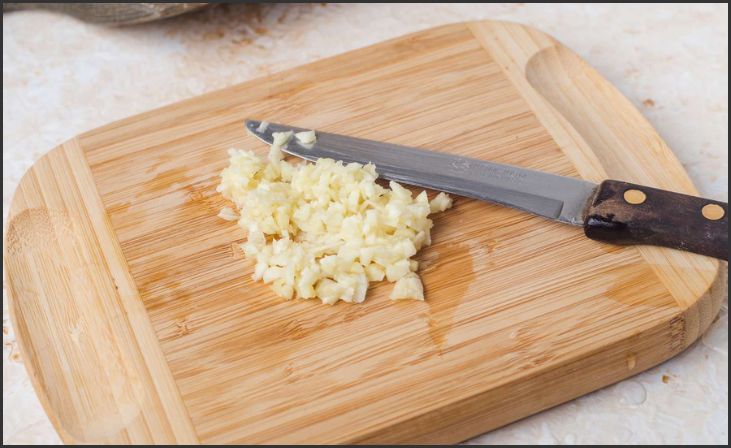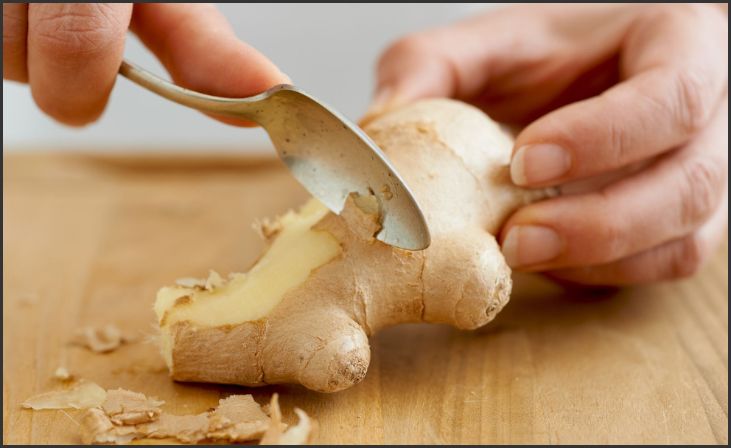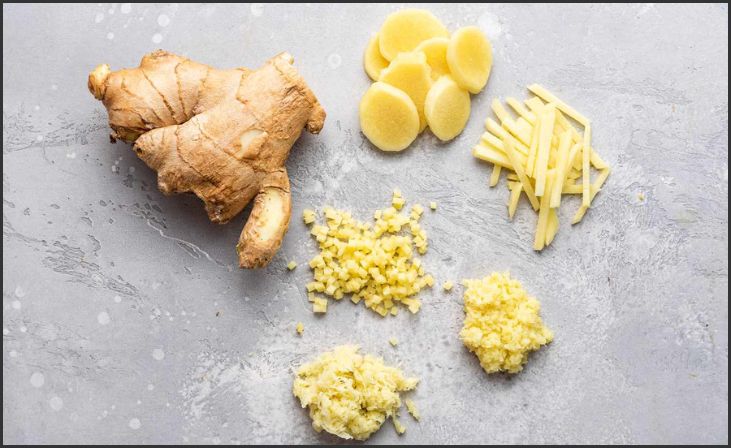Ginger is a staple ingredient in many cuisines around the world, known for its unique, pungent flavor and many health benefits. However, preparing ginger can be a bit of a challenge, especially if you’re not sure how to mince ginger properly.
Discover the easy and efficient way to mince ginger and make it a staple ingredient in all your beloved recipes. Learn the proper techniques of peeling, grating, and finely chopping fresh ginger root to enhance the taste of your dishes.
In this guide, we’ll walk you through the process of mincing ginger quickly and easily, so you can enjoy its delicious taste and health benefits in any recipe.
What Is Mincing?

Mincing is a cooking technique that involves finely chopping or dicing food. The resulting pieces of food are typically small, evenly sized, and have a consistent texture.
Mincing is often used to prepare ingredients for dishes such as soups, sauces, stews, and sautés, but it can also be used to prepare ingredients for appetizers, salads, and other types of dishes.
When mincing, it is important to use a sharp knife and to chop the food with a consistent slicing motion, as this will result in more evenly sized pieces. A food processor can also be used to mince food quickly and easily.
Fresh vs Dried Ginger
Both fresh and dried ginger offers many health benefits and enhances the taste of dishes. While dried ginger is convenient and easy to store, I prefer using fresh ginger in cooking as it imparts a stronger, more robust flavor and has more flexibility.
Using either peeled or unpeeled ginger in your food can immediately boost its taste. Fresh ginger root can be kept in the refrigerator for up to one month or even longer in the freezer. So, I always stock up on ginger and use it when needed, whether it’s grating or mincing it.
What tools are necessary for mincing ginger?
Those are some common tools that can be used to mince ginger. Here’s a list of tools that you can use:
- A sharp knife: This is the most important tool for mincing ginger. A sharp knife will make the task much easier and safer. A chef’s knife or a paring knife can be used to mince ginger.
- A peeler or spoon: You’ll need to remove the skin from the ginger before mincing it. You can use a peeler to peel the skin off or a spoon to scrape it off.
- A grater or zester: If you want a very fine mince, you can use a grater or a zester to grate the ginger. This is optional, as you can also use a knife to mince ginger into a fine consistency.
- Cutting board: having a cutting board makes the process more comfortable and less messy.
Overall, the tools you use will depend on the desired consistency of your minced ginger and your personal preferences.
How to Clean Ginger?
Cleaning ginger is relatively simple. Here are the steps you can follow:
- Rinse the ginger under running water to remove any dirt or debris.
- Use a brush or the rough side of a sponge to gently scrub off any remaining dirt or debris.
- Peel the ginger using a spoon, a vegetable peeler, or the edge of a teaspoon. Ginger skin is thin and easy to peel, so you don’t need to use a lot of force.
- Rinse the ginger once more to remove any remaining bits of peel.
- The ginger is now ready to use. You can slice, dice, mince, or grate it as needed for your recipe.
How to peel ginger?

There are a few different methods that you can use to peel ginger. Here are two common ones:
Scraping method: This simple method uses a spoon or a knife to scrape off the skin. Hold the ginger root firmly with one hand and use the spoon or knife to scrape off the skin in a downward motion.
Be sure to hold the root firmly to avoid slipping and hurting yourself. This method is good for removing the thin, papery skin, but it may not remove all the fibers.
Peeling knife: A peeler knife specially designed for peeling ginger, it has a curved blade that can easily peel ginger skin off. Hold the ginger root firmly with one hand and use the knife to peel off the skin. You can make shallow or deep cuts as you peel around the ginger.
Regardless of the method you use, it’s important to start with a fresh ginger root that has smooth skin, as old or dry ginger will be more difficult to peel. Whichever method you use, be sure to clean the ginger root thoroughly once the skin is removed to remove any dirt or debris.
Types of Cuts for Ginger
There are several different types of cuts that can be used for ginger, depending on the recipe or dish you’re preparing. Here are some common types of cuts for ginger:
- Julienne Cut: This is a thin, matchstick-sized cut commonly used as a garnish or in stir-fries.
- Finely Chopped: This is a small, finely diced cut that is used in sauces, marinades, and dressings.
- Minced: This is a very small, finely chopped cut that is used in seasoning, marinades and dressings, soups, and stews.
- Grated: This is a very fine, powdery cut that adds flavor to dishes like ginger lemonade, pastries, and marinades.
- Sliced: This is a thin, flat cut, used for various dishes and for pickling, also for slices cand.
- Coarsely Chopped: This is a larger, roughly diced cut, often used in soups, stews, curries, and when ginger is used to infuse liquids.
It’s worth noting that the recipe and how you want to use ginger would sometimes determine the type of cut you need. However, mincing ginger and grating ginger are the most common types of cuts for ginger for various reasons, and that’s why they are widely used.
How to mince ginger?
There are several ways to mince ginger, and the method you choose will depend on the desired consistency of your minced ginger and your personal preferences. However, here are three common methods:
Using a knife: This is the most common method, requiring a sharp knife. First, peel the skin off the ginger root using a spoon, butter knife, or peeler.
Then, cut the ginger root into small, thin slices. Next, stack several slices together and cut them into thin strips, then cut them into small cubes.
Finally, turn the knife on its side and use a rocking motion to mince the ginger to the desired consistency.
Using a grater or zester: This method is good for obtaining a very fine mince. First, peel the skin off the ginger root and then grate it using a box grater or a zester.
Be careful when grating ginger, as it can be quite tough on the skin.
Using a food processor: This is an efficient method if you have a lot of ginger to mince or if you want a very fine mince. First, peel the skin off the ginger root and cut it into small chunks.
Pulse it in a food processor until it reaches the desired consistency. Keep in mind that using a food processor can make the ginger become wet, depending on how long you process it.
When mincing ginger, use caution and be aware of the blade at all times. If the ginger root is too tough, you may have to use a more pointed knife to work through it.
How to store fresh ginger?
There are a few different ways to store fresh ginger to keep it fresh for as long as possible:
Room temperature storage: You can store fresh ginger at room temperature by placing it in a dry, dark place, such as a pantry or cupboard. However, the ginger will spoil more quickly at room temperature than if it’s stored in a cooler location.
Refrigeration: You can store fresh ginger in the refrigerator by wrapping it in a paper towel or a perforated plastic bag. The towel or bag will help absorb excess moisture and keep the ginger fresh for up to 3 weeks.
Freezing: Fresh ginger can also be stored in the freezer, either peeled or unpeeled. When frozen, the ginger will last for up to 6 months. Just wrap it tightly in plastic wrap or a freezer bag. You can easily grate or mince frozen ginger directly out of the freezer with no thawing required.
Pickling: You can also pickle ginger by peeling, slicing, or grating it, adding it to a jar, and covering it with a vinegar-based solution (such as rice vinegar, white vinegar, or apple cider vinegar). This process can make ginger last for up to 6 months in the fridge.
Choose the storage method that works best for you, and depending on your usage, you might want to consider a combination of different methods, such as storing it in the fridge when you just brought it and freezing some of it for later use.
Health Benefits of Grated or Minced Ginger Root
Grated or minced ginger root is known to have several health benefits.
- Anti-inflammatory properties: Ginger contains compounds such as gingerols and shogaols, which can help to reduce inflammation in the body. This can be beneficial for conditions such as osteoarthritis and rheumatoid arthritis.
- Digestive aid: Ginger can be helpful in promoting healthy digestion and relieving symptoms such as bloating, gas and constipation. It’s also been known to help alleviate nausea, a common symptom during pregnancy or after chemotherapy.
- Pain relief: The anti-inflammatory compounds in ginger can also help to reduce pain, making it a natural remedy for headaches and menstrual cramps.
- Antioxidant properties: Ginger contains antioxidants that can help to protect the body from free radical damage and reduce the risk of certain types of cancer.
- Cardiovascular benefits: Consuming ginger may also lower blood pressure and help to reduce the risk of heart disease by decreasing the level of LDL ( bad) cholesterol.
Most studies on the health benefits of ginger used large doses, therefore consuming small amounts of ginger in food may not give the same effects. It is best to consume ginger regularly as a spice in food or in a supplement form to get the most benefits.
Why is ginger used in cooking?

Ginger is a versatile and flavorful root that offers a range of benefits, both medicinal and culinary. It belongs to a family of spices like cardamom and turmeric and is commonly used in fresh and dried forms.
Its strong and pungent aroma, along with its intense taste, adds warmth and depth to dishes, both sweet and savory.
Fresh ginger imparts a unique, zesty flavor that can range from pungent to warm and garlicky, that can tingle the senses, and leave a lasting impression. It elevates the flavors of dishes and can transform even the most basic meals into something truly delicious.
What Is Ginger Root Good for?
Ginger is a powerful ingredient that perfectly balances its bold flavor with potent medicinal properties, making it perfect for anti-inflammatory remedies like shots and tinctures.
It’s also a great natural remedy for relieving nausea and addressing stomachs and digestive issues such as motion sickness and morning sickness. Furthermore, ginger has been known to aid in managing blood pressure and heart health.
How can I use fresh ginger?
Fresh ginger is a versatile ingredient with a unique, spicy flavor that can be used in a variety of dishes and drinks. You can use it in cooking, baking, beverages, pickling, cand or cocktail making.
Some ways to use ginger include adding it to stir-fries, soups, curries, marinades and rubs for meats, fish and vegetables, gingerbread, cookies and cakes, teas, smoothies, and juices, pickling it in a vinegar and sugar solution and cand by simmering it in sugar syrup.
You can use ginger either grated or minced, and add more to taste.
Can you mince ginger before time?
Once the ginger is minced, transfer it to jars or containers with tight-fitting lids. Allow the ginger to sit at room temperature for a minimum of two weeks.
While it can technically be used after a few days, its flavor and texture will be at their peak after the two week fermentation period. If not used it may begin to lose flavor and dry out.
Why is ginger minced?
Ginger is often minced because it can be more easily used in cooking and food preparation in its minced form. In addition, minced ginger has a smaller, more consistent size and can be added to recipes in the desired amount without the need for additional chopping or grating.
It also allows for better distribution of the ginger throughout a dish, ensuring that each bite has the desired amount of ginger flavor.
Is Minced Ginger the Same as Grated Ginger?
Minced ginger and grated ginger are not the same things, although they can be used interchangeably in many recipes.
Minced ginger is ginger that has been finely chopped into small pieces and has a slightly more textured appearance. It is often used in stir-fries, marinades, and sauces.
Grated ginger, on the other hand, is ginger that has been passed through a grater to produce fine, dry flakes, and it is often used as a garnish or to add a strong ginger flavor to dishes like gingerbread, cookies, curries, and marinades.
Both minced and grated ginger can be stored by freezing. In summary, minced ginger is small visible chunks, and grated ginger is a fine pulp.
Do you peel ginger before you mince it?

It is recommended to peel ginger before mincing it, as the skin can be tough, fibrous, and bitter. The skin also might not blend well in a recipe. You can use a peeler, spoon, or a small knife to peel the ginger.
It’s also possible to buy pre-peeled ginger, but it tends to dry out faster, and it’s best to peel it as you need it. Once minced, it’s recommended to use it within a few days to retain freshness, flavor, and texture.
Conclusion
To mince ginger effectively, peel the skin with a spoon, ensuring minimal waste. Use a sharp knife to slice the ginger into thin matchsticks, then finely chop into small pieces. Alternatively, employ a grater or food processor for quicker results. Mincing ginger enhances its flavor and aids in even distribution throughout dishes. Experiment with various methods to find what suits your preference and recipe requirements.
FAQs
Slice peeled ginger into thin matchsticks and finely chop them with a sharp knife. Alternatively, use a grater or food processor for quicker results.
While a garlic press may work, it’s often more effective to use a knife, grater, or food processor for ginger due to its fibrous texture.
Mincing enhances ginger’s flavor by releasing its natural oils. Experiment with different methods to find the texture that complements your dish.

Leave a Reply